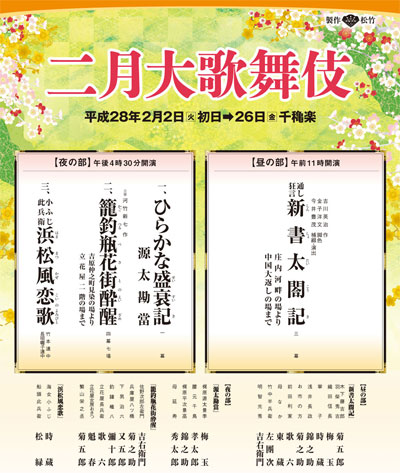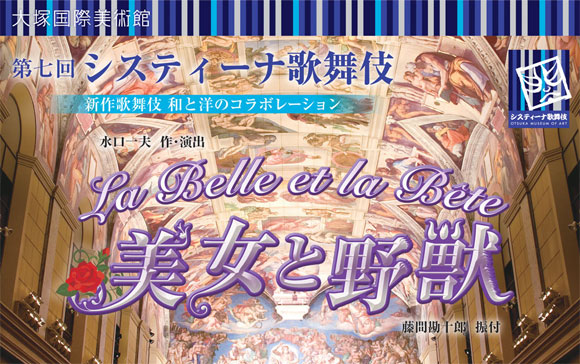| FEBRUARY 2016 |
|
3 shows in T˘ky˘ (Kabukiza, Orchard Hall), 1 in Fukuoka (Hakataza), 1 in ďsaka (ďsaka NHK Hall), 1 in Naruto (ďtsuka Museum of Art) and 1 tour (Zenshinza)!
|
| Kabukiza (T˘ky˘) |  |
| Dates | 2 ~ 26 February 2016 (Nigatsu ďkabuki) February Grand Kabuki |
| MatinÚe |
Shinsho Taik˘ki |
| Evening |
Hirakana Seisuiki (Genta Kand˘) Hamamatsu Kaze Koi no Yomibito (Kofuji Konobŕ) |
| Casting |
Living National Treasure Onoe Kikugor˘, Living National Treasure Nakamura Kichiemon, Nakamura Tokiz˘, Nakamura Baigyoku, Onoe Kikunosuke, Nakamura Kaishun, Kataoka Hidetar˘, Kataoka Takatar˘, Nakamura Kinnosuke, Ichikawa Sadanji, Band˘ Yajűr˘, Onoe Sh˘roku, Ichikawa Danz˘, Band˘ Hikosabur˘, Kataoka Ichiz˘, Nakamura Karoku, Nakamura Matagor˘, Nakamura T˘z˘, Kataoka Kamez˘, Kawarasaki Gonjűr˘, Nakamura Matsue, Sawamura S˘nosuke, Sawamura Yoshijir˘, Band˘ Kamesabur˘, Band˘ Kametoshi, Nakamura Kash˘, Nakamura Baishi, ďtani Hirotar˘, Nakamura Yonekichi, Band˘ Shingo, Nakamura Tanenosuke, Nakamura Mantar˘, Kataoka Matsunosuke, Arashi Kitsusabur˘, Nakamura Kamenoj˘, Ichimura Kitsutar˘ |
| Comments |
The troupe for these February Grand Kabuki performances at the Kabukiza is led by two Living National Treasures, Onoe Kikugor˘ and Nakamura Kichiemon. The Taik˘ki-based drama "Shinsho Taik˘ki", with Nakamura Kichiemon, Onoe Kikugor˘ and Nakamura Baigyoku in the roles of Kinoshita T˘kichir˘/Hashiba Hideyoshi, Akechi Mitsuhide and Oda Nobunaga, which was based on Yoshikawa Eiji's 1941 eponymous novel, was staged for the last time 20 years ago, in February 1996 at the Kabukiza. The evening program ends with a rarity: the dance "Hamamatsu Kaze Koi no Yomibito", which was staged for the last time in January 1954 at the Shinbashi Enbuj˘.
|
 |
|
|||
| Dates | 4 ~ 21 February 2016 (Nigatsu Hanagata Kabuki) February Young Actors Kabuki |
||
| Program |
Ninin Fuji Musume |
||
| Casting |
Living National Treasure Band˘ Tamasabur˘, Nakamura Shid˘, Nakamura Kotar˘ |
||
| Comments |
Living National Treasure Band˘ Tamasabur˘ performs in Fukuoka at the Hakataza in a special Buy˘ program. He plays the roles of Shizuka Gozen and the ghost of the warrior Taira no Tomomori in the dance-drama "Funa Benkei". He also performs in "Ninin Fuji Musume", a special version of "Fuji Musume" which was premiered in January 2014 at the Sh˘chikuza with Band˘ Tamasabur˘ and Nakamura Shichinosuke. This time the second wisteria maiden is Nakamura Kotar˘.
|
||
| Zenshinza Tour | |
| Dates | 3 ~ 28 February 2016 |
| Program | |
| Casting |
Kawarasaki Kunitar˘, Arashi Yoshisabur˘, Fujikawa Yanosuke, Yamazaki Tatsusabur˘, Anegawa Shinnosuke, Matsunami Kihachir˘, Masuki Hiroshi |
| Comments |
A 2-month 34-date (17 in January and 17 in February) tour all over Japan:
|
| ďtsuka Museum of Art (Naruto) |
| Dates | 19 ~ 21 February 2016 (Sistine Kabuki) |
| Program |
La Belle et la Bŕte (Bijo to Yajű) |
| Casting | |
| Comments |
7th edition of the Sistine Kabuki, a Kabuki program within the Sistine Hall of the ďtsuka Museum of Art, which is located in the city of Naruto (Tokushima prefecture). Inside this museum, there are more than 1,000 replicas of priceless masterpieces of Western art, from ancient murals to modern paintings, which are reproduced in ceramic to their original size. The Sistine Hall is of course a "reproduction" of the Vatican Sistine Chapel. This newly-created play is based on Marie Leprince de Beaumont's fairy tale "La Belle et la Bŕte". More precisely, it is based on Jean Cocteau's 1946 movie adaptation "La Belle et la Bŕte", which was somehow related to Kabuki. In May 1936, Jean Cocteau was in T˘ky˘ at the Kabukiza, where he could enjoy Onoe Kikugor˘ VI performing in the dance-drama "Kagami Jishi". In this dance-drama a young girl is transformed into a resplendent shishi. This transformation inspired Jean Cocteau when he conceived and directed his own "La Belle et la Bŕte". |
 |
| Orchard Hall (T˘ky˘) |
| Dates | 1 ~ 2 February 2016 (GRAND JAPAN THEATER) |
| Program |
Sanbas˘ Tsuchi-gumo Kagami Jishi |
| Casting |
Ichikawa Ebiz˘, Ichikawa Kudanji, Ichikawa Fukutar˘, Kanze Yoshimasa, Shigeyama Ippei, Umewaka Kish˘ II, Kamei Tadao, Kamei Hirotada |
| Comments |
Ichikawa Ebiz˘ leads in T˘ky˘ at the Orchard Hall the GRAND JAPAN THEATER, an original troupe which gathers Kabuki, N˘ and Ky˘gen performers. |
| ďsaka NHK Hall (ďsaka) |
| Dates | 5 ~ 6 February 2016 (GRAND JAPAN THEATER) |
| Program |
Sanbas˘ Tsuchi-gumo Kagami Jishi |
| Casting |
Ichikawa Ebiz˘, Ichikawa Kudanji, Ichikawa Fukutar˘, Katayama Kur˘emon X, Kanze Yoshimasa, Nomura Taichir˘, ďtsuki Bunz˘, Kamei Tadao, Kamei Hirotada |
| Comments |
Ichikawa Ebiz˘ leads in ďsaka the GRAND JAPAN THEATER, an original troupe which gathers Kabuki, N˘ and Ky˘gen performers. |
|
|
| Contact | Main | Top | Updates | Actors | Plays | Playwrights | Programs | Links | FAQ | Glossary | Chronology | Illustrations | Prints | Characters | Derivatives | Theaters | Coming soon | News |
